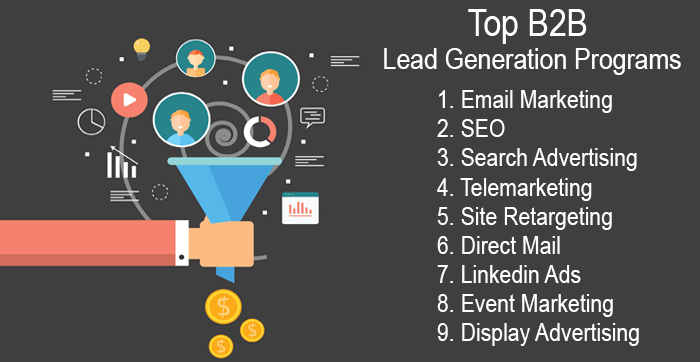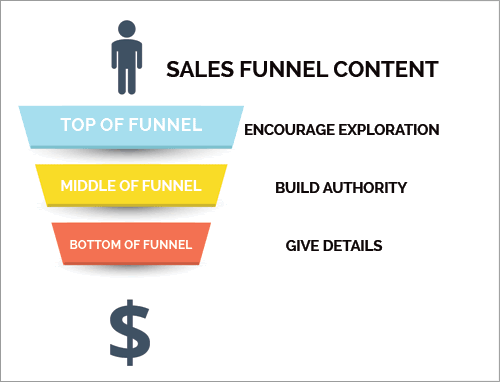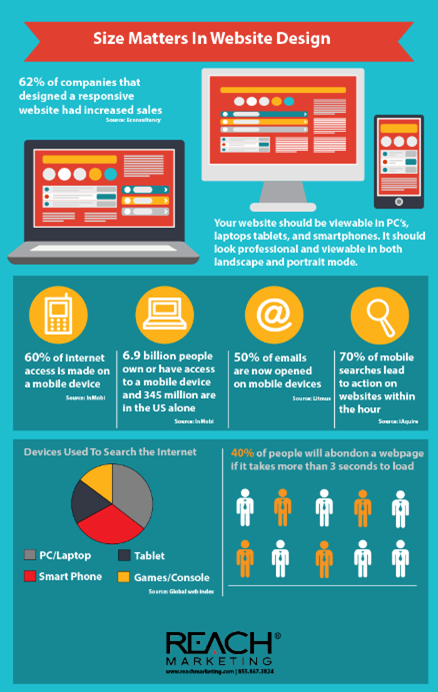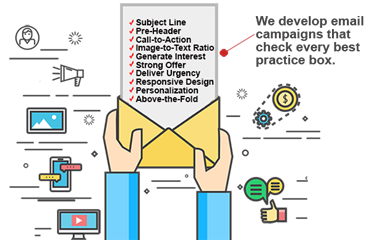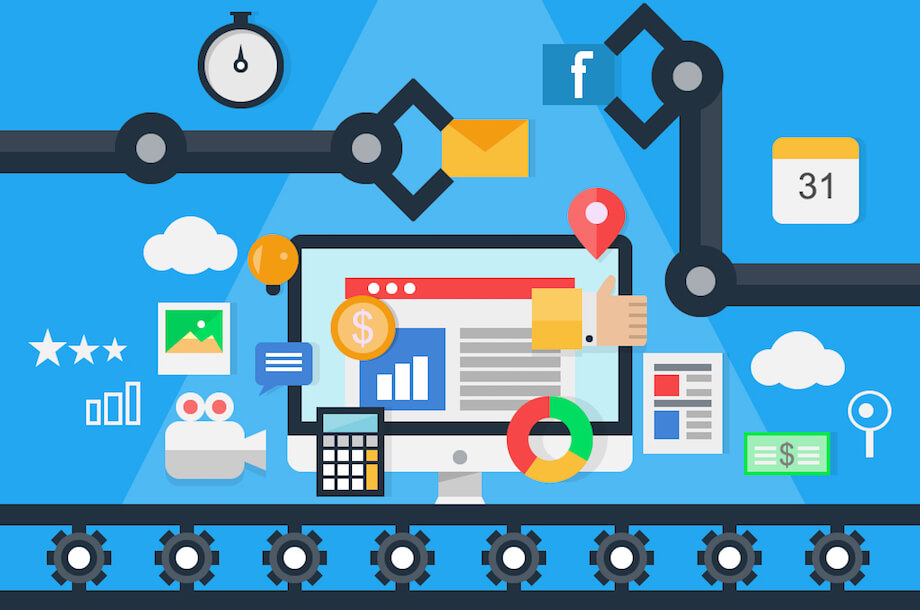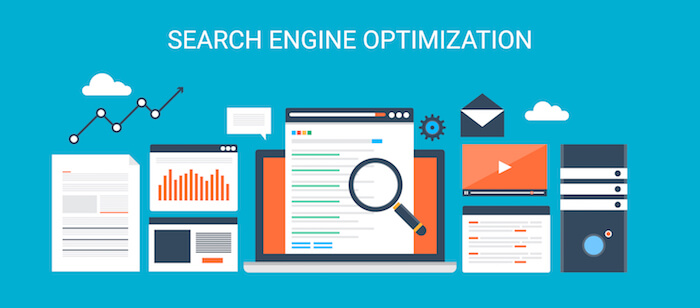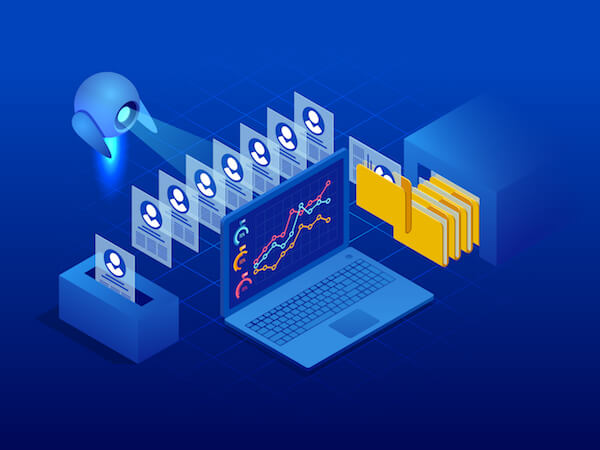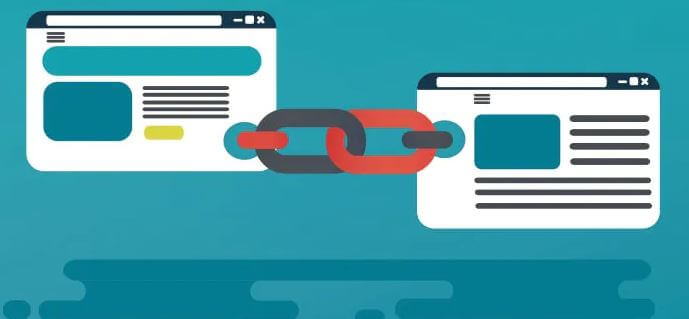B2B Lead Generation : 78 Strategies That Get Results
Your company’s success depends on it in today’s online marketplace. And now, more than ever, there’s intense focus on Lead Generation, a fundamental concept in modern B2B marketing. Simply put, on-point lead generation leads to a bigger sales pipeline, more closed deals, and higher revenue for your organization.
Before today’s buyers make purchasing decisions, they use the internet, social media, and a wide array of content platforms to discover their options and research everything they want to know. During every step of your buyers’ journeys, you want information about your products and services right there in front of them, so they’ll discover you’re the expert, and clearly the winning choice.
The key to successful B2B lead generation is to plan, experiment, evaluate, then adapt. There are several proven lead gen options for you to try which perform well for B2B companies like yours including:
- Website Design and Optimization
- Email Marketing
- Marketing Automation
- Digital Advertising (PPC, etc.)
- SEO Optimization
- Social Media Advertising
- Database Marketing
- Content Marketing
In this guide, we’ll briefly discuss B2B lead generation, talk about why it’s important, and then provide over 78 helpful tips and tricks that can empower you to own the lead gen and B2B sales arena in your industry.
Increasing B2B Sales – Top Proven Steps
To increase B2B sales, you must have a well-performing lead generation process that will align marketing and sales so they can work as a team to win customers. By understanding the process in terms of a simple funnel, you can track where your prospects are in the journey, send them appropriate content and website links, then get them over to sales when they are ready to consider a purchase. Our first tips center around the sales funnel concept:
1. Break down the buyer’s journey.
It’s critically important to understand the modern B2B buyer’s journey, the process through which a prospect is identified first as a qualified lead, then as a prospect that needs to be nurtured, and eventually as a buyer and a loyal repeat customer. It’s a helpful framework to use when considering which tactics will best suit your team’s goals.
2. The prospect moves through three distinct stages of the sales funnel:
- Top of Funnel – Attract prospect, encourage exploration, capture contact info. At this early stage, the goal is to catch a prospect’s attention with content that interests, educates and builds awareness around a business challenge – one that you can solve. Good options for top-of-funnel content include: articles, short-form social media blasts, SEO articles, overview blog posts, infographics, brief YouTube videos, and promotions. The goal is for them to want to share their contact information with you so you can move together to the next step in the funnel.
- Middle of Funnel – Nurture and engage prospect as you build authority. Now that the prospect has shared their contact information, thus indicating their interest, it’s time to start building a trusted relationship by sharing thoughtfully crafted content, informative resources, and offers to help them decide to buy. Middle-of-funnel content can include: comprehensive blog posts, calculators and self-tests, e-books, white papers, articles, subscription-based content, newsletters, and incentives to buy now.
- Bottom of Funnel – Convert prospects to customers with details and answers. At this late stage in the journey through your sales funnel, it’s time to get down to details and specifics about why your services or products are the best and only choice. At this point, it’s a given these clients are considering you or they wouldn’t have made it this far down the sales funnel. Make sure your content validates that you are the only option. Bottom-of-funnel content often includes: case studies, deep-dive webinars, testimonial videos and pricing promotions.
3. Understand your organization’s buyer personas.
It’s also more important than you might think to take the time to create accurate personas for each of your potential customers. Each buyer persona will include a detailed description of people who will use and/or buy your product. These fictional profiles, ranging from a young specialist to a seasoned CXO, will help you understand the characteristics of each member of your target audience. Once you’ve created these individual buyer personas, you’ll have the ability to develop targeted messages for each segment and increase your chances of connecting because it’s obvious you understand their specific pain points.
4. WEBSITE DESIGN
Your website is your digital storefront and the first experience most prospects will have with your brand. From the minute they land on your page, it has to be inviting, memorable and easy to use, and that all stems from outstanding website design. Consider the tips below to improve your website design:
5. Beautify your website
It’s important to make your website intuitive and inviting. Create a sleek and engaging website design that welcomes visitors and encourages them to convert due to seamless functionality, interactive elements, and eye-catching design.
6. Size matters when you’re designing your site.
Check out the infographic below to help you decide which elements you want to include and how large your website will be:
7. Watch your conversions soar with powerful landing pages.
Well-performing landing pages include vital information for the visitor and deliver compelling solutions to your visitors’ problems. Make sure your landing pages have the following features so you can attract and convert more B2B leads.
- Visually pleasing content (text and graphics)
- Helpful, informative copy
- SEO-friendly keywords
- Ease of use for visitors
- Feeling of urgency
- Single purpose
- Social proof/testimonials
- Several calls-to-action throughout the page
8. Keep your promise
Your ads connect to landing pages. If your ad offers something, be sure to follow through and deliver what you enticed them with. We’ll talk about PPC advertising more in-depth in a bit, but if you’re already using it, make sure your ad leads to a landing page that matches what the ad promised (such as technical information, special offers, free trials, etc.) or they’re likely to leave your site and hop over to your competitor’s.
RELATED: SaaS Lead Generation Tips
9. Website Optimization
Your users want your website to be attractive, informative, and intuitive. In addition, you need prospects to find you with ease, and when they do, your site had better run smoothly and quickly. When all this is happening, your website is optimized. If any of the above-mentioned “parts” are broken, you can be sure you are losing sales.
Here are some suggestions to help you improve your search engine optimization (SEO) and improve your website’s chances of landing on page one of search-engine results.
10. Get up to speed.
The speed at which your website operates is vital to ensure a positive user experience. If your website speed is slow, you can be sure it is negatively affecting your bounce rate, not to mention your conversions. On average, if your website takes longer than 3 seconds to load, approximately 40% of your visitors will abandon your site!
11. Broken links stink.
Sending a potential customer to a page that does not work conveys a bad message. No one wants to do business with a company that does not fix broken things. Worse yet, it interferes with your team’s ability to generate quality organic B2B leads, and it can get you penalized by Google. To audit your site for broken links, use a tool like SEMrush or reach out to get expert help.
12. Get personal with dynamic web pages.
People who visit websites have come to expect a personalized experience, and when it comes to B2B lead generation, it is in your best interest to make sure it is happening by employing dynamic web pages and content that is tailored to your visitor. The user will see their name (at the very least) while more robust pages might include their company’s name, location, industry and more.
13. This is a test
A/B testing, also known as split-testing, is where you share two different versions of a web page with different sets of visitors at the same time, then compare which of the two drives more sales conversions. The insight you gain helps you utilize the most effective marketing messaging.
14. Zhuzh those landing pages.
If they are not attracting as much attention as you need, it’s time to make some minor upgrades to your website’s landing pages. Some quick fixes might include updating the page titles to align with stronger keywords, adding more intriguing call-to-action cues, and including strong and visually engaging testimonials.
15. Invite them in with irresistible interactive infographics.
Users can explore datasets and information for themselves with interactive infographics by hovering a mouse over mapped areas, clicking on different spots that interest them, or panning and zooming. These can be fun, and sometimes businesspeople just need that! Infographics work because they deliver information in a visual way that is easy to understand. Plus, they can be shared and that’s always good.
16. Email marketing
B2B marketers have been using email as one of their primary B2B lead generation tactics for over 20 years now and it still works surprisingly well. The bonus is that it is a relatively low-cost and effective B2B lead gen tactic.
17. Give yourself a break and automate.
One of the most important email marketing trends of 2021 is email automation. If you are still running your email campaigns manually, it’s time to do things more efficiently. Automated email refers to a process where messages are sent to prospects automatically from your email service provider in direct response to individual users’ specific actions on your website. This happens in a timely manner via automated email so your company reps are responding in real-time with one-to-one messages to strengthen customer engagement, boost sales, and increase customer retention and loyalty.
A well-orchestrated email marketing program makes it easy to launch more campaigns in less time, add segmentation and targeting capabilities, and provide more and better reports to prove an excellent return on your company’s investment.
18. Say hello with personalized email marketing.
In email marketing, personalization is key. Top email marketers reach their prospects with targeted, useful, relevant content or promotional offers that gain attention and inspire engagement. A survey by the ANA revealed that email still delivers the highest return on investment at 4,300%! Additionally, 77% of prospects and customers say they prefer email communication with businesses like yours, especially when the experience feels like it is personally directed to them and their concerns. Emails with personalized subject lines get higher transaction rates – six times higher, according toExperian – recipients are far more likely to be open emails that are personalized.
19. Inspire engaging interactions.
When you give customers the chance to interact with the marketing content you send them, they’ll feel more engaged than those who simply read, then discard. Consider services such as Accelerated Mobile Pages which allow you to add interactive content directly into your marketing emails, creating the opportunity for your customers to read, vote, or even shop without having to click-click-click to get to the right page. This ultimately means fewer barriers between you and your next sale.
20. Dazzle ‘em with catchy subject lines.
A boring subject line has killed many an opportunity simply because the recipient wasn’t inspired enough to open it. To create compelling subject lines that prospects will want to click, keep them short, engage people with humor, trigger their curiosity, and personalize any communications you can. And, of course, outside support is always available to help you get creative and send killer emails.
21. Add mood-evoking pops of color.
Different hues can evoke different emotions and drive action – blue = trust, yellow = joy, and black = luxury. Be sure to use relevant colors in your marketing emails to drive engagement while simultaneously increasing your brand awareness and even your click-through rates.
22. Congratulations on your engagement! (Now do it again.)
One email engagement is not enough. You must also have a re-engagement campaign to remind your customers about all the cool things you’re offering like software updates, new training opportunities, exclusive discounts, new products, and services related to their previous purchases.
23. Inject powerful and persuasive words.
Once your prospects open an email from you, you’ve got to keep them there. Craft your communication wisely by sprinkling in a few “power words” to transform “blah, blah, blah” into persuasive punches that compel readers to take action. These special words might inspire an emotion like fear, insecurity, safety and more and, when used well, they inspire calls-to-action. Here are just a few examples of power words that you can include, sparingly, within your copy to get the response you want from your audience:
- Competition
- Pitfall
- Danger
- Mistake
- Secure
- Covered
24. Boost open rates with transaction emails
A transaction email confirms actions your prospects and customers have taken on your website and the open-rate can be 8 times higher than any other marketing email! It’s a great way in, after which you can increase engagement, offer specials, renew contracts and upsell.
RELATED: Business Leads for SaaS Companies
25. Mention the value, STAT!
“What’s in it for me?” asks every customer ever. So why keep them guessing? Lead with your value proposition because the more value you can provide your customers in your email campaigns, the more they’ll enjoy receiving your communications each month. When that happens, it’ll be exponentially easier to guide them towards taking the actions you want them to take.
Also, always make sure there is something of value to your contacts in every email. In most cases this can be as easy as providing a link to existing content from your company’s library that will help them or provide some insight to them. Plainly put, you’ll get better results when you send valuable content on a consistent basis, especially when it relates to their pain points or concerns. This will help you earn more clicks and maximize your email marketing success.
26. Use eye candy in emails to attract visual buyers.
When you use emojis as a part of your email communication, it can instantly add some personality and fun to your messages. They’re expressive, and can effectively engage audience members who are attracted to visual elements rather than words by instantly grabbing their attention. In fact, over 50% of all major brands are now using emojis in their subject lines and are boasting higher open rates. Consider adding GIFs and short videos as well.
27. Don’t panic, it’s organic.
The ideal email list is largely comprised of leads you’ve earned organically. And, your house file should be updated continuously to make sure your data is accurate. You can get help using email hygiene to clean these up. Three simple ways to build your list of organic email contacts are to:
Add calls-to-action to every single piece of your content
Publish valuable and popular content and gate the really good stuff, requiring contact information in exchange for the insights you’re providing
Place a “subscribe to our blog” form in the footer of your website
28. Be chill and send out some cold B2B emails.
Cold emailing, like cold calling, involves reaching out to people who don’t know you or anything about your company, and hoping you can convince them to become interested in what you’re promoting. Get it right, and cold email outreach can be a powerful B2B lead generation and sales tool. Include your full signature, your value proposition, and some social proof or testimonials to allow others to sing your praises.
29. Sweeten the deal when following up with B2B leads.
Following up on B2B leads is crucial. And many sales have fallen through the cracks because someone didn’t follow up. Timing is a huge part of the success equation. In fact, plan to follow up within 1 hour of your initial connection. And try to include an asset they’d like.
30. MARKETING AUTOMATION
If you’re ready to efficiently engage prospects with information that’s directly relevant to them and is delivered at the right time and stage of their buyer’s journey, you’re ready for marketing automation. When you send emails, content and informational links that mean something to the recipient, that address a pain point or offer a solution to their specific challenges – it builds valuable trust and understanding between you and your prospective buyers. This trusted relationship can often lead to bigger and better deals for longer terms.
31. Grow your business with a powerful online presence.
Marketers use marketing automation to plan, coordinate, manage and measure all their campaigns. With more time and better organization, you can significantly increase your digital presence, optimize your sales funnel, and build a solid foundation for continued growth and sustained success for your organization.
32. Digitize those workflows.
Roughly one quarter of a marketing department’s time is spent on repetitive tasks. Nobody has time for that when marketing automation is a powerful, readily available tool to help you get more B2B leads. Replace tedious, high-touch manual processes with automated solutions to keep up with and surpass your competitors. In addition, digitizing your workflows reduces the likelihood of human errors, gives your team more agility to handle other important tasks, and helps your company avoid compliance risks.
33. Help sales and marketing finally get along.
While implementing your marketing automation solutions, both your B2B sales and marketing teams should be involved in the planning and creation of these workflows in an organized, logical way that makes sense to all. When the two entities work together when setting things up, you’ll be able to include key marketing processes and core marketing tasks which will ultimately enrich your sales funnel to improve your customer acquisition rate.
34. Get a bird’s-eye view of prospects’ digital marketing experiences.
Rather than trying to manually track all your prospects through the various stages in the sales funnel, marketing automation will provide you with a holistic view with tools to provide a unique digital experience for each user. You’ll also gain the ability to engage with them on multiple levels through a variety of platforms.
35. Automate your buyers’ journeys to get the timing just right.
Implementing personalized automated nurture programs. will give you the ability to streamline paths to engagement and purchases. Once you’ve captured the attention and contact information of prospects, it’s time to nurture them with relevant content and solutions to their problems in order to warm them up for sales. When you input what datasets you want to use for campaigns, based on buyer persona and pain points for example, your marketing automation platform will do the brunt of the work for you! Then, when the time is exactly right, prospects can be routed to a sales rep to close the deal. It’s yet another way to grow your customer base.
36. Use lead scoring to track when a prospect is ready, steady, go.
Lead scoring is based on a point system that assigns values based on a person’s online and behavior. These actions can help you gauge where the buyer is on their journey and what their sales readiness is. Typically, sales and marketing teams will work together to determine how many points a prospect will get for different activities. For example, when a prospect reads a blog post he may earn 2 points, while downloading a white paper is a bit more of a time investment and indicator of a deeper interest, so that activity may earn 5 points.
Someone who responds to a prospecting email is more likely to be ready to buy, so this activity might earn 10 points. Once a lead has accrued enough points (based on what you’ve defined), they can be passed to sales, flagged for follow-up, or transferred into a more accelerated nurture program. Lead scoring is a crucial piece of the B2B demand generation machine. In fact, organizations that use lead scoring see a 77% increase in their lead gen ROI.
37. Measure results and use data to optimize campaigns.
You need to understand what’s working with your demand generation programs and what’s not working, and how to make tweaks to optimize accordingly. This is a great opportunity for you to reevaluate where your marketing efforts and dollars are going. By measuring the effectiveness of your efforts, you can then focus your attention on the areas of the funnel that aren’t working as smoothly. Take a look at things like:
- Average Deal Size
- Cost Per Acquisition
- Cost Per Lead
- Time To Close
- Closing Percentages
38. Mix things up by choosing multiple platforms
Use your marketing automation tool to orchestrate the use of multiple touchpoints – including email marketing, inbound marketing and social media – to engage in continuous conversations with your buyers. Throughout all 3 stages of the funnel and after the sale, marketing automation enables you to engage across an assortment of channels because it helps you connect email messages to website engagement, browsing habits to landing pages, and social media usage to nurturing efforts. Use the analytics within your marketing automation software to track every prospect and customer.
39. Make them love you even more.
Use your marketing automation platform to keep your current customers engaged by developing and deploying a loyalty and rewards program. Watch them transform from happy customers to enthusiastic brand advocates.
40. Mobile-friendly Marketing
It’s common knowledge that smartphones and mobile devices are powerful tools that we all use for entertainment, education and shopping. At the same time, the CXOs in your company may express surprise when you tell them just how big a role mobile now plays in the B2B buying process. if your site isn’t mobile-friendly, you’re giving competitors a huge advantage when it comes to attracting potential buyers who use their smartphones to research and make their purchases.
41. Don’t forget to cater to B2B buyers with mobile devices.
In this 24/7 marketing environment, your users’ needs come first, so your content must adapt to what they want. That’s why it’s imperative to make your website and content accessible to B2B buyers who use smartphones and tablets. No worries when you make websites, content pieces, email offers, and landing pages that look great and work seamlessly on mobile devices. Today it’s easier than ever to check your site’s compatibility with mobile devices, and you can always reach out to an expert in mobile-first design.
42. Take one step further and optimize for mobile users.
Your website, ads, and marketing content have to be more than just mobile friendly – make sure they’re mobile optimized. The most common ways to accomplish this is to use mobile-specific development platforms.
43. Prevent needless flipping with responsive design.
While optimizing your website for mobile, remember to include responsive design on your checklist. A responsive website has a dynamic layout that adjusts according to the size and orientation of the user’s screen. When design is responsive, it allows your users to have more pleasant experiences during their visits to your site.
44. Paid Advertising
Online paid advertising, as opposed to earned or owned advertising, requires you to purchase ad spots to attract online traffic. Paying for online advertising is more complex than your average transaction because customer actions play a role in the price. Featured ads are displayed on designated websites, and marketers or companies bid against their competition for keywords that pertain to their services or products.
45. Dive into Pay-Per-Click (PPC) advertising.
PPC is an online advertising model where you, the advertiser, pays each time a user clicks on one of your online ads that links to your website or content. A PPC campaign can give your firm great visibility on the first page of search results and the ability to reach a large, targeted audience.
A great example of PPC ads are the all-text ads that look like search results. These show up above (or next to) the top search results on Google and other search providers. As the name suggests, you pay based on the number of viewers that click on the ad. To stay within your budget, you can place a limit on the number of clicks allowed within a certain timeframe.
Firms that manage their PPC-spend as data-driven business investments, backed by careful keyword research and analytics, can expect to drive quality leads and higher revenue. To manage this somewhat complex yet vital component in your marketing mix, you can always reach out for help from professionals who specialize in PPC.
46. Grab eyes up front with display advertising.
Making online display ads an important part of your B2B marketing strategy can help you gain a measurable source of leads and revenue. The banner ads you see along the top portion of websites are a perfect example of display advertising. The fee structure is generally based on the number of times the ad is displayed on host sites with no clicks factored in. Display ads come in a variety of shapes, sizes, and designs and they often include audio, video, and other eye-catching media.
47. Draw attention by blending in with native advertising.
Using native ads to promote your brand can be a good way to combine advertising and content marketing. This native advertising often appears as “recommended reading” boxes that accompany news and information on websites, and the content appears to be “native” because the ads are designed to look like related editorial content. Many B2B marketers use this type of ad to promote content like blogs, videos, how-to lists and more.
48. Aim at the target, fire, repeat ad nauseum for the bullseye
You know from personal experience, often when you visit a website, you’re not ready to buy yet. The same is true for the majority of your visitors. That’s why you must include retargeting as a crucial marketing tactic. Retargeting allows you to keep your brand in front of your prospects after they’ve moved on from your website, helping to persuade them to come back to your company when they’re ready to buy. Serve retargeting ads through third-party networks like Facebook and Google Display Network because it gives you the opportunity to reach them through multiple websites.
49. SEARCH ENGINE OPTIMIZATION (SEO)
Web searches are now the primary way B2B buyers begin looking for solutions to their business problems. When someone searches for the products or services you offer, having your company’s name show up in the first few spots on Google and other search engines will have a profoundly positive impact on your marketing results.
Successful marketers understand the weight and value of Search Engine Optimization. SEO is the practice of increasing both the quality and quantity of your website traffic, as well as exposure to your brand, through organic (non-paid) search engine results.
50. Include these 8 SEO essentials
Search engines hold the keys to your organization’s success. Sites that excel at aligning themselves with what search engines want using solid site architecture, natural keyword strategies and compelling content are optimized for high placement on search engine results pages. SEO (search engine optimization) lends some sites greater weight than their competitors when users search for them. These eight SEO essentials use a site’s structure, content and social signals to propel it to first-page status on search engine results:
- Title Tag
- Headers and Sub Headers
- Valuable Unique Content
- Outstanding Page Performance
- Keyword-Rich URL Structure
- Keywords and Keyword Density
- Social Media Visibility
- Effective Link Building
Because fewer than 20% of users ever look past the first results page, SEO is crucial to reaching your next customer. Read the 8 SEO Essentials for a detailed examination and more tips for success.
51. Optimize your content for Google (oh yeah, and for the searcher).
Google’s main objective is to make search results more satisfying to the searcher. That’s why they (and other search engines like Bing) are constantly changing and fine-tuning their search algorithms to improve results and make it harder for companies to cheat. The plain truth is this: high quality content is what searchers want most, so it is what search engines prize most. It’s the one dependable constant and your knowledge of that will inspire you to continue to share top-quality material.
52. Hit the bullseye with targeted keywords.
Keywords are the words and phrases people type or speak into search engines to find what they’re looking for. A targeted keyword is one word or phrase that best summarizes what you’re offering. This is what you think (and hope!) people will enter into a search engine to find your website or content. When you include targeted keywords in your content, you’re far more likely to attract high-quality traffic from search engines.
53. Don’t monkey around – use long-tail keywords.
Long-tail keywords are generally longer (more than 3-words), and contain highly specific phrases people use when entering queries in search engines. Basically, as keyword terms become more specific and thorough , search volume becomes less competitive, but searcher intent becomes higher. Because of this specificity, these long-tail keywords might help you rank higher in search results for specific topics more quickly.
54. Metadata matters, man.
So what is it? Metadata is sort of a shorthand version of information about the data in your systems. Using metadata ensures that you’ll be able to find the data you need quickly and easily, use it, preserve it, and then use it again in the future. Metadata is essential for maintaining historical records of long-term data sets, and it can be created automatically to contain basic information, or manually to capture the specific details you define.
55. Jumpstart your SEO optimization with these simple steps.
Use these SEO strategy tactics to help your brand start showing up towards the top of the first page during online searches:
- Optimize site structure for engine searchability and visitor readability
- Create attractive page elements, including metatags, descriptions, and accessibility tags
- Include highly relevant stemmed keywords and phrases used naturally in original content
- Generate compact, complete HTML without missing or dead links
- Don’t be afraid to get help from people who excel at SEO optimization
56. SOCIAL MEDIA
Social Media lead generation is all about engaging via social apps with your customers and prospects and promoting your company, culture, and mission in an approachable way so that they’ll seek out your products and services when they need them.
Every modern marketing department’s growth strategy centers around plans to acquire more customers, and there are lots of ways to generate qualified B2B leads with social media. Here are just a few:
57. Take advantage of Facebook and LinkedIn lead forms.
Both platforms make it very easy to collect leads through their built-in lead generation forms. When people tap your ad on either social media channel, a form pops up that’s pre-populated with their contact information, and it’s sent directly to you.
58. Attract visitors with lead magnet offers.
To get prospects to share their valuable contact information, you need to offer them something valuable. For example, figure out which business issues most frequently plague your audience, then create content that will genuinely help them address their pain points. From there, you can promote gated, downloadable content in the form of ebooks and whitepapers that contain solutions to resolve their challenges.
59. Let others speak for you.
Just ask the Kardashians… influencer marketing has proven to be a very effective strategy to drive leads on social media—especially in the B2B arena. The right influencers are people who love your product and services and want to share the news. This boosts awareness of your brand as they carry your product marketing message to new potential leads, resulting in increased web traffic to your landing pages.
60. Slide into some DMs.
You can also prospect for new opportunities through the use of direct messaging (DM). People talk about their likes, dislikes, and problems on social media. If you practice a bit of social listening, you can strategically time your contact via DM and position yourself as someone who can provide the solutions they need.
61. Inspire info-sharing with fun and games.
You can grow your business online by creating gated social contests and giveaways. If you provide enticing activities with cool prizes, people will want to participate, and will be willing to share their contact information to gain entry. Fun events to consider include: photo caption contests, sweepstakes, comment and follow, share and retweet, tag a friend, and more.
62. Score high-value leads on LinkedIn.
LinkedIn is rich with opportunities for high-value B2B lead generation. Although competition is fierce and the cost-per-click is more expensive than on other platforms, you gain the ability to hyper-target your audience. But, to see the best returns from your advertising efforts on this platform, you’d better offer something of real value to this business-savvy audience, like high-end B2B services or valuable educational materials.
63. Tell them Mark sent you.
When planning for long-term social-selling campaigns, consider connecting with buyers through Facebook groups. Just remember, the biggest mistake you can make is to go in with sales-y pitches right off the bat. Start by building genuine relationships and establishing thought-leadership by supporting members and offering insights. You’ll know when it’s the right time to share a case study or a story about how you delivered a solution to someone in a similar predicament.
64. DATABASE MANAGEMENT AND MARKETING
Take a good look at any successful business, and you’ll find a company that practices outstanding database management and understands the value of every piece of incoming information.
Database marketing is a form of direct marketing that starts with your team collecting customer data like names, addresses, emails, phone numbers, transaction histories, etc. Marketers analyze this information and use it to attract potential buyers and create personalized experiences for customers.
Traditional direct marketing centers around the creation of direct mail assets such as brochures and catalogs and mailing them to a list of potential or current customers with the goal of inspiring action. Database marketing takes it further with a quest to understand how customers want to be marketed to, and then to apply those insights to fulfill each customer’s needs.
65. You’ve collected some great data – so use it.
Database marketing transforms data into actionable information, generates growth, and improves ROI. Data now flows in from hundreds of sources, and today’s top marketers combine their skills with vast computing power to leverage it.
66. Make like an orange and segment.
Use your database to segment your users and create targeted campaigns. One idea might be to create a campaign specifically for first-time buyers. For another, you could tailor a campaign aimed at past customers you’d like to bring back into the fold.
67. Sniff out potential upsell and cross-sell opps.
You have data about all your contacts, deals you’ve made, contracts, open/closed accounts and more. By analyzing this information, you can pinpoint which customers are likely to purchase bigger or related services based on specific data that you choose.
68. CONTENT MARKETING
In today’s self-driven buyer’s journey, content rules. Use a variety of content to help prospects get to know you and learn what solutions you offer that can help them. With quality content, you can:
- Attract potential B2B buyers
- Educate your audience
- Differentiate your organization
- Establish your thought-leadership
- Redefine and strengthen your brand identity
- Create loyalty from your customers
69. Start spreadin’ the news.
Newsletters educate your audience and help to keep your brand in front of prospects and customers on a consistent basis. They’re a great way to stay connected, increase web traffic, grow your social media community, manage your reputation, demonstrate industry authority, and generate B2B leads and sales.
70. Be a white knight with your white papers.
White paper content addresses key concerns and solutions within a specific vertical or market. In the B2B sector, most buying decisions go through multiple layers of approval. Provide your prospects the information they need to persuade other decision-makers with custom-written white papers that supply in-depth knowledge about your company’s solutions. Because they provide such valuable information, most marketers gate their white papers and send them to their bottom-of-funnel leads.
71. Don’t rest your case.
Pay attention to this staggering number: 92% of B2B customers base their decisions on at least one online review! Case studies, especially when they’re accompanied by testimonials, can help you showcase how other B2B brands are successfully using your solution. To create the most effective B2B case studies, use a data-driven approach to address common or specific customer pain points.
72. Lights, camera, action!
Written content is important, no doubt, but content marketing professionals worldwide now report that video content is bringing the highest ROI for them in today’s marketplace. Additionally, marketers who create video content earn an average of 66% more leads per year according to the Aberdeen Group. Follow up with prospects after they finish a video, and you can further nurture and qualify your B2B leads by gating video content that’s longer.
73. Use webinars to teach and reach.
In a sense, webinars are like an online trade show, but without any other vendors to compete for your prospects’ attention. As with trade shows, you’ll guide the conversation with people who are attending because they have a vested interest in the subject matter. Moreover, you get to do it repeatedly because webinars last for as long as you have them available on your website so people can watch them whenever they choose. A tradeshow only happens once, but a webinar can funnel well-educated, highly qualified leads to your sales team time after time.
74. THINK OUTSIDE THE BOX
Every tip mentioned above is a tried-and-true B2B lead generation tactic. Here are a few more slightly less traditional, yet still effective lead gen tips that can help you attract even more potential customers:
75. If you build it, they will come
Create a helpful tool that will allow your leads to try an aspect of your product or services before they buy. Some companies build simple calculators while others might offer a scaled-down version of their product to interested prospects who can take it for a spin before they pull the trigger on a purchase.
76. Be a pod person
Podcasts are a fun, contemporary and alternative way to generate B2B leads. With podcasting you can create free industry-specific content by featuring thought leaders and well-respected industry players. Surrounding any given podcast, you can use social media to advertise the show, post blogs containing the gems of knowledge your guest shared, send tweets about relevant and inspirational quotes from the episode and more. And the cherry on top is that your guest will probably share the podcast with his or her followers, and that is a glorious thing.
77. Spend some advertising dollars on the next best Bing.
Google is awesome. Google is also expensive. Consider allocating some of your advertising spend on Bing. The concept behind both search engines is the same: they’re both pay-per-click advertising platforms designed to help businesses reach specific audiences, drive traffic, and increase revenue. Microsoft-owned Bing actually has three search engines – Bing, Yahoo, and AOL – so when you advertise on one platform, your ad is actually seen on all three. This may give you an advantage over marketers who are only advertising on Google.
78. Amp up with affiliate marketing.
Affiliate marketing is a performance-based marketing tactic that enables businesses to increase sales by allowing others who are targeting the same audience (“affiliates”) to earn a commission by recommending the product to them. These affiliates can recommend products and services by sharing information about them through their websites, blogs, webinars, social media platforms and more. They earn a commission every time a customer makes a purchase through the unique link associated with their recommendation.
CONCLUSION
We’ve covered a lot of ground in this white paper. Hopefully, we’ve answered some of your questions and offered you a whole host of B2B lead generation tactics that could work very well for your company. Now it’s time to outline your priorities and chart your existing capabilities when it comes to landing new B2B customers and keeping the ones you’ve got.
If your resources are limited, pay particular attention to tactics where low-cost options – like running a carefully targeted PPC ad campaign, or creating a basic content marketing plan – can deliver solid results.
Overall, the takeaway here is that you aren’t alone in trying to figure out the best strategy to win qualified B2B leads. In fact, over 75% of B2B marketers say generating high-quality leads is their top challenge.
Here’s the simple truth: when planned and executed well, B2B lead generation delivers a steady stream of new, qualified prospects. This results in a fatter sales pipeline, more closed deals, and higher revenue for your company.
Want more information? We are your experienced resource, here to help you gain knowledge and confidence with a wide spectrum of winning B2B lead generation strategies.
==
B2B Lead Generation FAQs
- What is B2B Lead Generation?
- What is the B2B Sales Funnel?
- Is Lead Generation Sales or Marketing?
- How Do You Generate Leads?
- What Is Your Lead Generation Method?
- Is External Lead Generation or Internal Lead Generation Better?
- How Much Does B2B Lead Generation Cost?
- Is Lead Generation Worth It?
- How Long Does It Take to See Results from B2B Lead Generation?
- What Results Can I Expect from Procuring B2B Lead Generation Services?
What is B2B Lead Generation?
B2B lead generation is an essential sales and marketing activity in which a company identifies and attracts potential business customers for their product or service. Lead generation initiates a potential customer’s interest in a business’ product or service and brings them into the sales funnel.
What is the B2B Sales Funnel?
A B2B sales funnel depicts how leads are captured and progressed through various levels of engagement before they make a purchase or exit the funnel. The sales pipeline reflects on the salespeople’s activities during the sales process, as well as the potential for revenue at any given moment.
Is Lead Generation Sales or Marketing?
Lead generation can be either sales, marketing, or both. Based on their goals for sales or customer acquisition, organizations can subsequently decide what their lead generation goals are and adapt the approach to meet said goals. For example, Leads, once acquired, might be added to the marketing department’s newsletter list, to the sales department’s cold-call list, or to both.
Some companies use lead generation to attract potential long-term customers to a recurring service, so they might choose to use private access blogs, white papers, or webinars as a way to generate customer interest. Other organizations might be more interested in attracting leads to a direct sales conversation and would adapt their methodology to meet that goal.
Many businesses choose a mix of both methods and use lead generation in both sales and marketing to accelerate their growth.
How Do You Generate B2B Leads?
Leads can be generated in a number of ways. You might choose to host closed webinars where a potential customer trades his contact information for entry; create downloadable content that a person can access by providing their email; send out targeted email campaigns; employ chatbots on your company’s website; or simply cold call a targeted list of prospective clients. You can also contract with a B2B lead generation company to provide you with quality leads for a postal, email, or telemarketing campaign.
Once two-way communication has been established between the lead and a business, the lead is considered “generated” and a sales conversation can begin.
What is Your Lead Generation Method?
At Reach Marketing, our successful lead generation method is based on growth, using both outbound and inbound tactics to nurture audience growth, engage potential customers and facilitate a future sales conversation between your organization and mature leads. We focus on producing higher quality leads, which ultimately accelerates your growth faster than lower quality, higher quantity leads.
Is External Lead Generation or Internal Lead Generation Better?
Internal lead generation refers to having an internal team develop your leads; while external lead generation involves hiring a third party service to complete the task for you.
While there are benefits to both styles of lead generation, external lead generation is generally considered to be more cost effective, more aptly targeted and produces higher quality leads than internal lead generation. This is due to the fact that an external service typically specializes specifically in lead generation, and thus has a larger portfolio of businesses and contacts across a range of industries, thus amplifying your message across a more extensive market. External sources are also more skilled at developing well-matched leads, meaning that you are more likely to have a successful sales conversation once the leads are passed to the sales team.
How Much Does B2B Lead Generation Cost?
Lead generation can be charged per lead, or per month, depending on your organization’s specific needs. An average cost per lead might be ten cents; while an average monthly lead generation service might range from $3-5k per month.
Is Lead Generation Worth it?
If your goal is growth, then lead generation is worth putting resources towards. Businesses can be grown in two main ways. You can dedicate more marketing dollars to encourage existing customers to spend more on your products or services, or you can add new customers. If you choose the second growth tactic, then lead generation is essential to your growth strategy.
How Long Does It Take to See Results from B2B Lead Generation?
Many B2B purchases involve approval from multiple decision-makers, especially ones with a high-ticket expense, so often they have a long sales cycle. Typically, they have timelines that can range from 6 months to 2 years, or more. The longer the sales cycle, the longer it will take to generate the full benefits from lead generation.
What Results Can I Expect from Procuring B2B Lead Generation Services?
The ROI on lead generation services is usually dramatic. Potential customer pools increase exponentially, and if your sales funnels are effective, then sales will quickly follow. If you have any questions about lead generation services, please contact us today.
How Does B2B Lead Generation Work?
The B2B lead generation process of identifying the ideal customers for your product or service, then attracting them to buy is an essential activity. It’s key in building relationships with potential buyers and keeping up-to date on industry trends so you can effectively communicate these benefits at any time!
Before you can draw new business to your company, you need a pool of potential customers – those are your leads. Lead generation means building awareness and generating interest in an audience through quality marketing programs that ensure more high-quality leads pouring into your sales funnel.
B2B Companies Need Lead Generation Solutions
When polled, 70% percent of business owners and executives agreed that their biggest concern was lead generation – yet fewer than 10% described their current efforts as highly effective. When your company relies on our proven methods of lead generation, you can see an exponential rise in your numbers of new prospects. Call the Reach Marketing team today and discover how effective B2B lead generation can transform your business.
Top B2B Lead Generation Programs
- B2b Leads via List Brokerage
- B2B Leads via Email Marketing
- Online Lead Generation
- B2B Leads via SEO
- B2B leads via SMO
CPC AND CPL – B2B Lead Generation
Gain new customers quickly through Reach Marketing’s quality lead generation program. Our proprietary CPC and CPL lead generation network delivers business leads from every industry within all professional levels from small firms to large Fortune 500 companies.
Our syndicated network provides professionals with essential content they need to gain a competitive advantage both professionally and personally, including white papers, webinars, product downloads & more.
Reach Marketing can also provide expertly crafted lead generation solutions to help you design, implement, track and measure your lead generation campaign.
How does it work?
1. Provide us with your content for syndication through our network of qualified business professionals.
2. Choose your specific data criteria such as name, business address, email address & other individualized options from an array of customizable data elements.
3. You only pay for the leads that meet your specific criteria, so start collecting leads right away.
Key Benefits from our B2B Lead Generation Campaigns
- Accuracy. Our 3 step contact communication ensures 100% record accuracy, guaranteed.
- Quick Turnaround. We have the ability to scale up or scale down our production to generate your desired quantity of high-quality leads.
- Custom Questions. Since we speak with each contact we can ask our captive audience any specific questions that you want answered to increase the value of each lead.
- Targeted Audience. Our business database comprises 50 million professionals enabling you to target your ideal audience with each program.
- Data Depth. Each record you receive will contain contact name, title, email, phone, company, postal address, and key firmographic data.
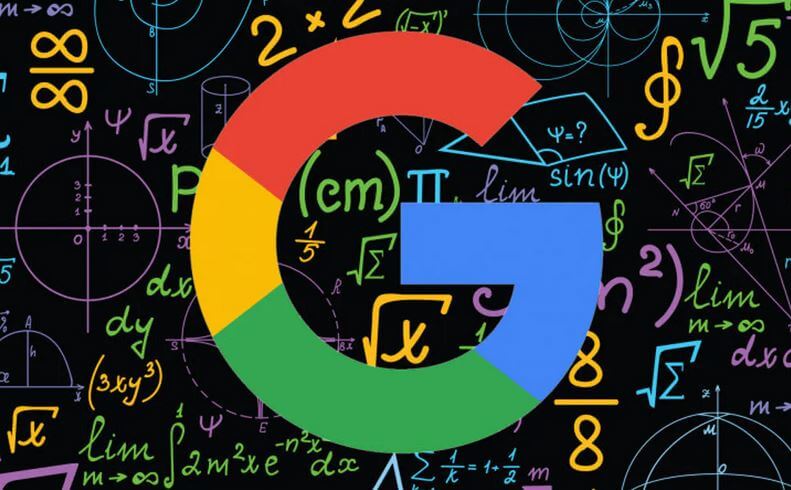
Top B2B Lead Generation Tips
An important tool for generating high-quality B2B leads is developing a substantial SEO strategy.
Here are 3 steps that will help you build your online presence and generate new, targeted leads through SEO.
- Keyword Research – Finding appropriate keywords is the first step to any effective SEO campaign. You can use online tools such as Google Trends, Google’s Keyword Planner, and even Google Autocomplete to help you discover popular search terms in your industry. Once you create a preliminary list of keywords you would like to target, you can use professional resources like SEMRush or ahrefs for more in-depth statistics, such as search volume, competitiveness, and estimated traffic each term. Once you have the data, prioritize your keywords to make sure you’re spending your time on search terms that will generate you the highest number of B2B leads.
- Content Creation – Creating valuable content is one of the pillars of any SEO The content on your website, in particular, is one of the most powerful tools for generating B2B leads. However, mass publishing irrelevant content can also have an adverse effect on your lead generation strategy. When attempting to rank for your target keywords, it is important to create informative/useful content focused on a topic related to your keyword itself. Creating high-quality content is certainly an important piece to the puzzle, but don’t forget to follow the best on-page SEO practices for your pages and posts. According to Demand Gen Report, “B2B buyers typically consume between 3 and 7 pieces of content before speaking with a salesperson.”
- Optimizing Existing Content – Return to content that you have already created and analyze the success these pages have at generating leads. Tracking and reporting tools like Google Analytics will provide you insight on what step website visitors are getting to in the lead lifecycle. Prioritize pages that generate high numbers in traffic but do not yet yield high numbers of B2B leads. If this is the case, rework your content to earn the trust of your visitors and add content that will drive visitors towards a form submission. There is no one-size-fits-all method for optimizing content in a way that will attract more leads. If you are struggling to bring in an adequate number of B2B leads you may want to consider speaking to a B2B marketing professional.
How to Use SEO for B2B Lead Generation?It is clear, more now than ever, that the B2B marketing landscape is continuously changing. Similarly, SEO is becoming increasingly challenging with more and more companies purchasing SEO packages to acquire new leads. However, statistics still support the fact that utilizing SEO is a straightforward path for generating B2B leads. In fact, according to Hubspot, “61% of B2B marketers say SEO and organic traffic is their top inbound marketing priority and they plan to dedicate “substantial marketing budget” to it.”. Adding SEO to your B2B Lead Generation strategies will yield many benefits. By adding some SEO-friendly content, optimized based on targeted keyword research, your B2B Lead Generation campaign can be quickly strengthened.
How PPC Advertising Can Increase B2B Lead Generation
PPC advertising from Google Adwords & Bing Ads is a critical component for any B2B company looking to increase lead generation.
PPC allows businesses to display their services or products to prospects looking for those offerings. The quality of the B2B leads generated from a PPC campaign are usually high. To achieve a decent ROI and high lead quality, your PPC Adgroup must have the right keywords and ads promoting your services/products. Lead generation via PPC is a process that requires changes to your PPC campaign to achieve a better conversion percentage. If you know the demographics of the leads you like to generate, PPC will allow you to select those variants:
- Age
- Gender
- Income level
- Location (cities, zip codes, counties, etc)
- Languages
- Education
- & many more
For B2B companies these filters can be advantageous because they can target those specific prospects without wasting marketing dollars on a broader audience.
B2B Lead Generation – Adwords Phrase Match
To increase the quality of your B2B leads, you should set your keywords PPC keywords to “exact match” for the phrases you are targeting. This setting will bring the quality traffic you are looking for by only matching the search phrase or query your prospects are using to find your product or service.
Best Lead Generation Landing Pages
Just like any other online B2B lead generation program, your landing page or destination page must have the right CTAs in place as well as benefits potential clients will receive should they purchase your service or product. These landing pages require a lot of testing (A/B testing) to be able to generate not just a healthy CTR but also conversions. If your B2B company requires several landing pages, tools like unbounce and instapages will save your web development team a lot of time.
We currently use both applications to generate high volume B2B leads under different industries. Our conversion rate’s range from 5% to 22%. The quality of the leads we produce for our clients are high and this helps shorten the sales cycle a bit.
PPC campaigns can improve the quality of your B2B leads. With the right PPC budget, you should expect a decent return. B2B Lead generation via Adwords or Bing ads requires planning and execution. If you are not familiar with any of these two advertising PPC models, you should hire a PPC management company. They will save you time, money and bring the b2b leads you need to grow your business fast.

